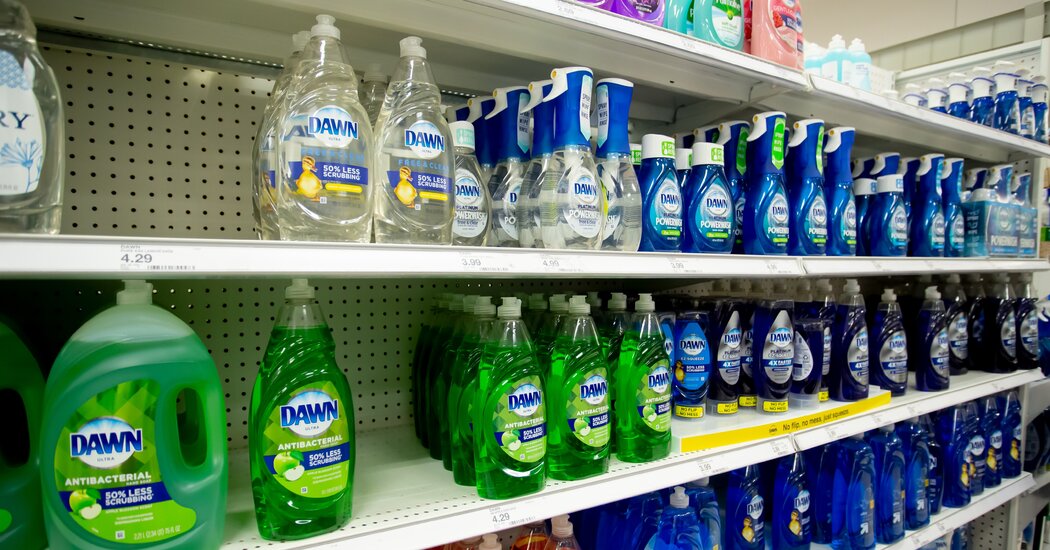A new round of price increases for household products such as Gillette razors, Dawn dish soap and Swiffer dusters bolstered Procter & Gamble’s operating results last quarter, the company said Friday, a sign that stubborn inflation may persist as companies defend their profit margins.
Procter & Gamble, a consumer goods gauge, said profits grew in the first three months of the year after it raised prices by 10 percent for all its brands. That increase marked the company’s second straight quarter of double-digit increases. Its profit margin grew in the quarter, with price increases more than offsetting the increase in what it paid for raw materials.
Sales rose 4 percent last quarter from a year earlier, even as sales volumes — the number of rolls of Charmin toilet paper and boxes of Tide laundry detergent — fell 3 percent as consumers switched to cheaper alternatives or bought less. In other words, Procter & Gamble made more money even though it sold fewer products. The company’s sales volumes have declined over the past four quarters.
“Consumer packaged goods companies are a relatively small portion of what contributes to the overall level of inflation,” said Sucharita Kodali, a retail trends analyst at Forrester, a research and advisory firm. But, she added, they “contribute greatly to the perception of inflation.” Customers don’t buy cars or houses every day, but many do notice price increases when they regularly go to the supermarket.
Jon Moeller, CEO of Procter & Gamble, said in a statement that the company delivered strong results “in what remains a very difficult cost and operating environment.”
The company also raised its revenue forecast for this fiscal year to a 1 percent increase over the prior year; the previous forecast was a range from flat to a 1 percent decline. And it said it planned to buy back $8 billion of its own stock in the current fiscal year, which ends in June.
Shares of Procter & Gamble closed more than 3 percent higher on Friday.
Americans have continued to spend in recent months even as companies passed on higher prices, but there are signs that consumers are beginning to pull back: U.S. retail sales fell 1 percent in March from the previous month.
Inflation is generally subdued, rising 5 percent through March, down from a peak of nearly 9 percent in the summer. The slowdown has been long and uneven, in part because companies are finding they can maintain higher prices, especially by marketing their offerings as premium products.
Procter & Gamble even had its own term for the high value of its products – “irresistible superiority” – which was used several times during a conference call with analysts.
Consumers are becoming more cautious about their spending, Andre Schulten, the company’s chief financial officer, said on the call. “That just means we need to redouble our view of what superiority means in some of our lower levels,” he added. That can include communicating the value and quality of products to consumers.
Other consumer product manufacturers have posted similar results following price increases. In February, PepsiCo said it would not raise its prices any further after multiple price increases caused it to post better-than-expected results in the fourth quarter. And Unilever said this year it would continue to raise prices, but reduce the increases in the second half of the year.
Higher prices can frustrate consumers, said Ms. Kodali, the Forrester analyst. Brand loyalists, or “inelastic customers,” are likely to continue buying products at higher prices, but other customers have already changed their shopping habits — as evidenced by Procter & Gamble’s drop in sales volume.
A customer turned off by rising prices for Pampers disposable diapers may turn to fabric alternatives instead. That customer will be difficult for Procter & Gamble to win back.
Higher prices may have helped corporate earnings, but they have hampered the Federal Reserve’s efforts to curb inflation by cooling the economy through a series of rate hikes that began last year. Late last month, the Fed raised its reference rate to a range of 4.75 to 5 percent, up from near zero just over a year ago.
In Europe, policymakers have warned that raising prices by firms above what is necessary to absorb higher costs could fuel inflation. Policymakers have long been concerned about the wage-price spiral, with higher wages prompting firms to raise prices to offset wage increases.
Now the so-called profit-price spiral can also pose a risk. A member of the European Central Bank executive warned last month that half of the eurozone’s domestic price pressures in the fourth quarter of last year came from corporate profits.
Executives at Procter & Gamble acknowledged on the call to analysts that there are still challenges ahead, such as higher operating costs and wage increases.
There are “a lot of headwinds that we are working against and will continue to work against as we go forward,” said Mr. Moeller.

